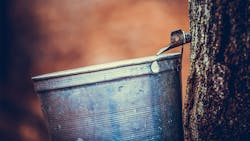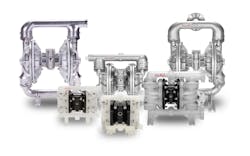Historically speaking, it was around 70 years ago that the filter press — which was invented a century earlier in the United Kingdom — gained a foothold as a first-choice technology in industrial liquid-handling applications in the United States. By their design and operation, filter presses are used as a tool in separation processes, namely where solids must be removed from a liquid stream. The “sludge” that is separated as the solid-laden liquid moves through the filter press can be easily removed and disposed of. The cleaned liquid can then be moved to the next stage of the production process, or recirculated back into the filter press for further processing.
In this role, the filter press has performed admirably in industrial applications, but in recent times, enterprising manufacturers of consumables, some of which must be produced in hygienic or sanitary operating conditions, have found that filter presses can further optimize their operations. This article will take a look at three markets and applications where filter presses can shine — one traditional, a second that has seen a reimaging of its production processes, and one that requires reliable operation in extreme conditions. Additionally, we will highlight the pump technology — positive displacement (PD) air-operated double-diaphragm (AODD) — that is proving to perform best with filter presses, no matter the industry or application.
Waste not, want not
Industrial water and wastewater applications are ones where filter presses have proven their worth from day one. This is an application where large volumes of solids and liquids need to be separated on a daily basis. The filter press is ideal for this application because of its method of operation. As the solid-laden slurry is pumped into the press, two chambers are filled, which facilitates the formation of thick slurry “cakes.” While the chambers fill, the pressure inside the system increases to the point that when the chambers reach capacity, the liquid is filtered out with the aid of streams of compressed air or water. This “dewatering” leaves behind solid slurry or sludge cakes that are ready for disposal.
A major advantage in this cake-creation process for the operators of water/wastewater plants is that instead of having to dispose of large amounts of wet slurry, the outcome is a flow of neutralized water and a comparatively small amount of cake, which reduces disposal costs.
To operate properly, filter presses require good filtration and constant system pressure so that the flakes that form the slurry cakes are not destroyed. This means that pressures of up to 100 psi (7 bar) are generally required. The filter-press process in water/wastewater treatment also requires that various types of ancillary liquids be used. In many cases, these liquids — including things like milk of lime, which is very abrasive, and a variety of alkalines — cannot be released into the environment. This necessitates the need for a reliable leak-free pumping technology that is compatible with a wide range of liquid types.
Creating a less-sticky situation
Everyone has at least seen a depiction of the manufacturing process for maple syrup: a series of buckets connected by plastic tubes are hung from maple trees, which are tapped, allowing their sap to flow into the buckets. When enough is collected, the sap is boiled over and over until it reaches the point that it can be called pancake-ready maple syrup. This is a time- and labor-intensive process, but one that was performed in that manner for hundreds of years.
That is until recently. It has only been in the last two or three decades that maple syrup production has become fully mechanized and modernized, with many producers now utilizing a “reverse osmosis” production process that reduces the time and cost to manufacture maple syrup. Enter the filter press — or as syrup manufacturers have begun calling it, the “syrup press.” Rather than repeatedly boiling the sap to create syrup, today’s process sees the sap passed through the filter press in what is called the evaporation stage. As evaporation occurs, the sap is separated into the sticky, syrupy solution we all recognize with a water-like by-product that is removed. To get the production process started, pumps are used to transfer the raw sap into the filter press at the beginning of the production process.
Surviving the deep freeze
There are some industrial production process that require the finished products to be manufactured with the aid of components that need to be separated in extremely cold operating conditions. In fact, in some cases this requires the use of a liquid like ethanol that has been cooled to a temperature that can be as low as -40ºF (-40ºC). It is at the beginning of these types of processes that pumps are used to push a mixture of the raw material and the super-cooled ethanol through the filter press.
Because many of these types of processes are also used in the production of goods made for human consumption, they must be produced under the strict auspices of hygienic/sanitary manufacturing regulations. This means that the pumps must not only be able to handle extremely low temperatures, but they also must be compliant with U.S. Food & Drug Administration edicts, as well as those of Europe’s Restriction of Hazardous Substances (RoHS) directive. Specifically, the RoHS 3 regulation lists the maximum levels (less than 1,000 parts per million) that can be present of such substances as lead, mercury and cadmium in finished consumable products.
Additionally, since ethanol is classified as an explosive substance, the pumps used in the production of goods that require it during the manufacturing process must be certified for use according to the ATEX Category II guideline that governs use in atmospheres that feature gases, vapors or air/dust mixtures that could explode.
The AODD solution
For those looking to optimize their filter-press operations, no matter the industry or product, AODD pumps offer a number of operational advantages, including dry-run capability, compatibility with liquids of varying viscosities and pressures, good controllability and an inherently leak-free design that features no gaskets or seals. AODD pumps also have no drives, rotating parts and rotary shaft seals.
Other PD pump technologies have been used in conjunction with filter presses, but each of the more popular ones have shortcomings that can prevent them from being the best choice:
- Piston diaphragm: Can be prohibitively expensive to operate since they require both electricity and air to function.
- Progressive cavity: Can’t dry run or handle large abrasives, and also require electricity to operate.
- Hose piston: Liquid transfer occurs through the use of hoses, which wear out faster than diaphragms and, at some point, will be at risk of a catastrophic failure.
In the end, AODD Pumps are able to outperform their PD cousins in filter-press applications because of their simple design and method of operation. A pair of diaphragms that are connected via a diaphragm rod work in unison to move the liquid through the pump. While one side of the pump is in suction mode the other is in discharge mode. As a diaphragm moves inward it creates suction. This suction causes the balls that are located on the check valves to move toward each other. As this happens, the ball on the top closes the valve while the ball on the bottom moves away from the valve, opening a path that allows the liquid to enter the pumping chamber.
As the diaphragm moves outward, the discharge motion causes the balls to move away from each other. As this happens the top valve opens and the bottom valve closes. This allows liquid to exit the chambers and discharge through the top port. This process constantly alternates between the two chambers to create a continuous cycle. The pump diaphragms are driven by pressurized air that is directed left and right by the movement of the main air valve.
The result is a pumping process that remains volumetrically consistent at flow rates of 200 gpm (757 L/min) or higher, even with varying liquid viscosities and transfer pressures. Startup is also as simple as attaching a compressed-air hose to the pump’s air distribution system (ADS) and turning it on. AODD pumps also require a smaller footprint than piston diaphragm or progressive cavity pumps, which allow them to be used in tighter operating areas.
Many manufacturers of AODD pumps are now also producing hygienic/sanitary models that can be used in the production of consumable products, or in operating atmospheres that require a pump with an ATEX rating. This further expands the operational range for AODD pumps that can be used in conjunction with filter presses.
Conclusion
The filter press has been proven to perform reliably in a number of industrial applications that require the separation of solids and liquids, but its application range, it has been found, does not end there. The producers of consumer goods, some of which are manufactured in extreme atmospheres, are finding that filter presses can be indispensable parts of their manufacturing operations, but only if partnered with the proper pump technology. More and more, the best technology for use with filter presses is proving to be the AODD pump, the operational characteristics of which can help optimize operations in a number of critical — and unique — industries.
Paul McGarry is a Sales Manager for All-Flo, a leading manufacturer of air-operated double-diaphragm (AODD) pumps and fluid-handling solutions for industrial markets. He can be reached at [email protected] or (440) 354-1700. All-Flo is a product brand of PSG, a Dover company. You can find more information on All-Flo at all-flo.com and on PSG at psgdover.com.
About the Author
Paul McGarry
Sales Manager for All-Flo and PSG.
Paul McGarry is a Sales Manager for All-Flo and PSG®, Grand Terrace, CA, USA, a leading manufacturer of air-operated double-diaphragm (AODD) pumps and fluid-handling solutions for industrial markets. He can be reached at [email protected] or (440) 354-1700. All-Flo is a product brand of PSG®, Oakbrook Terrace, IL, USA, a Dover company. PSG is comprised of several leading pump companies, including Abaque™, All-Flo, Almatec®, Blackmer®, Ebsray®, em-tec, EnviroGear®, Griswold®, Hydro Systems, Mouvex®, Neptune™, Quattroflow™, RedScrew™ and Wilden®. You can find more information on All-Flo at all-flo.com and on PSG at psgdover.com.

